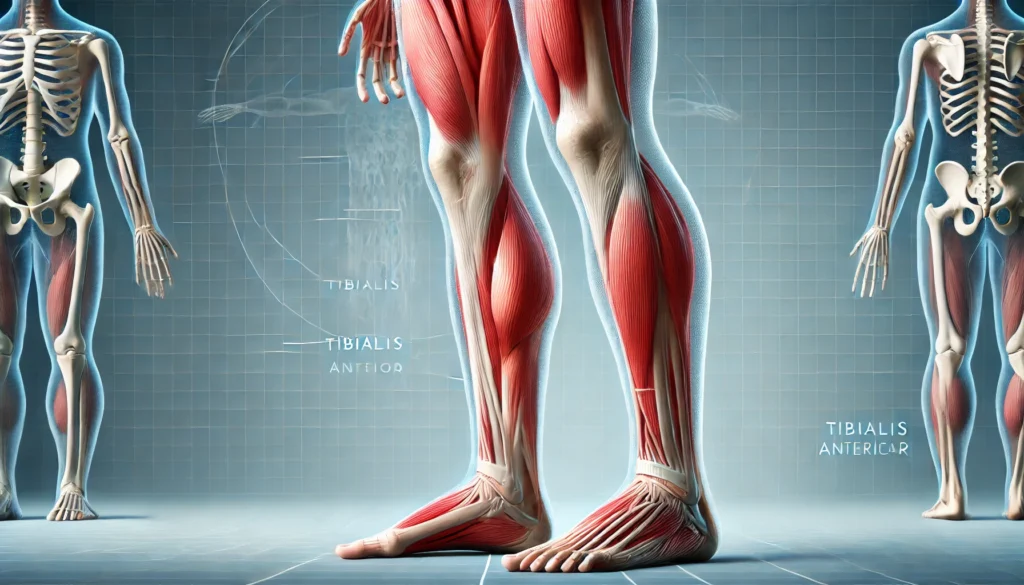
The tibialis anterior and tibialis posterior are two important muscles in the lower leg that play crucial roles in foot movement and stability. In this blog post, we’ll explore the anatomy and function of these muscles, as well as effective massage techniques to alleviate tension and pain.
Tibialis Anterior
Anatomy and Function
The tibialis anterior is the most medial muscle of the anterior compartment of the leg1. It originates from the upper 2/3 of the lateral surface of the tibia and the adjoining part of the interosseous membrane2. The muscle ends in a tendon that inserts into the medial and inferior surface of the medial cuneiform bone and the adjacent portion of the first metatarsal bone2.
The primary functions of the tibialis anterior are:
- Dorsiflexion of the foot at the ankle joint
- Inversion of the foot at the subtalar joint
- Stabilization of the ankle during walking and other activities
- Support of the medial longitudinal arch of the foot
The tibialis anterior is essential for activities such as walking, hiking, and kicking a ball1. It helps stabilize the ankle as the foot hits the ground and lifts the foot clear of the ground during the swing phase of walking2.
Massage Techniques for Tibialis Anterior
Massaging the tibialis anterior can help alleviate tension and pain associated with conditions like shin splints. Here are some effective techniques:
- Forearm or heel of hand massage: Apply massage oil or lotion and use the blade of your forearm or the heel of your hand to slide up the length of the tibialis anterior5.
- Thumb pressure: Use your thumbs to apply pressure along the muscle, starting gently and gradually increasing intensity. Hold each spot for about 30 seconds or until the sensation fades5.
- Self-massage with a hard object: Lean your shin against a hard object like a tennis ball or the edge of a bench. Apply pressure and move your leg to massage the muscle5.
- Foam roller technique: Use a small foam roller to perform precise rolling movements along the tibialis anterior. This method is particularly suitable for beginners8.
Tibialis Posterior
Anatomy and Function
The tibialis posterior is the most central muscle of the leg, located in the deep posterior compartment3. It originates from the inner posterior border of the fibula, the interosseous membrane, and the adjacent surface of the tibia3. The muscle’s tendon descends behind the medial malleolus and inserts into various bones of the foot, including the navicular, cuneiforms, and metatarsals3.
The primary functions of the tibialis posterior are:
- Inversion of the foot
- Plantar flexion of the foot at the ankle
- Support of the medial longitudinal arch of the foot
- Stabilization of the lower leg
The tibialis posterior plays a crucial role in maintaining balance, especially when standing on one leg, and helps distribute body weight when the foot is on the ground4.
Massage Techniques for Tibialis Posterior
Massaging the tibialis posterior can help relieve pain and tension, particularly for those experiencing heel pain or flat feet. Here are some effective techniques:
- Self-massage with thumbs: Sit comfortably with your affected leg raised. Use your thumbs to locate the muscle behind the tibia and apply gradual pressure to trigger points. Hold for about 30 seconds and release6.
- Ball massage: Sit with your target leg’s ankle supported on your opposite knee. Place a massage ball on the inner aspect of your shin bone and apply pressure within tolerable limits. Start at the midpoint of your shin and work your way down to the foot, moving 1 inch at a time7.
- Active release: While performing the ball massage, dorsiflex and plantarflex your ankle to achieve an active release of the muscle. Complete 3-5 slow repetitions per tender spot7.
- Posterior tibial tendon massage: Sit with your legs extended in front of you. Pull the targeted leg towards you, allowing your knee to drop outward. Use your thumbs to apply pressure along the tendon, starting from the inside of the ankle and moving upwards9.
Conclusion
Understanding the anatomy and function of the tibialis anterior and posterior muscles is crucial for maintaining lower leg health and preventing injuries. Regular massage of these muscles can help alleviate tension, reduce pain, and improve overall foot and ankle function. Whether you’re an athlete dealing with shin splints or someone experiencing foot arch issues, incorporating these massage techniques into your routine can be beneficial.
Remember to start gently and gradually increase pressure as you become more comfortable with the techniques. If you experience persistent pain or discomfort, consult a healthcare professional for a proper diagnosis and treatment plan.
Disclaimer: This content is for informational purposes only and is not intended to substitute professional medical advice, diagnosis, or treatment. Always seek the advice of your physician or qualified health provider with any questions you may have regarding a medical condition.
Citations:
- https://www.kenhub.com/en/library/anatomy/tibialis-anterior-muscle
- https://en.wikipedia.org/wiki/Tibialis_anterior_muscle
- https://en.wikipedia.org/wiki/Tibialis_posterior_muscle
- https://www.kenhub.com/en/library/anatomy/tibialis-posterior-muscle
- https://www.painscience.com/articles/spot-03-tibialis-anterior.php
- https://www.painalog.com/trigger-point-pain-from-tibialis-posterior-trigger-point-one-and-how-to-find-relief/
- https://www.rehabhero.ca/exercise/tibialis-posterior-release
- https://www.muscle-joint-pain.com/trigger-points/trigger-point-self-treatment/tibialis-anterior/
- https://www.physitrack.com/exercise-library/how-to-perform-posterior-tibial-tendon-massage
- https://www.rehabhero.ca/exercise/tibialis-anterior-massage
- https://pubmed.ncbi.nlm.nih.gov/7981805/
- https://www.youtube.com/watch?v=MdLFfHjGSIY
- https://www.physio-pedia.com/Tibialis_Posterior
- https://www.youtube.com/watch?v=-PUahsuhZPA
- https://www.physio-pedia.com/Tibialis_posterior_rupture
- https://www.ncbi.nlm.nih.gov/books/NBK539913/
- https://www.youtube.com/watch?v=AMv0LzkMet8
- https://www.youtube.com/watch?v=xE-eTA_S11U
- https://www.youtube.com/watch?v=ZnOxavk9bZI
- https://www.thegameplanpt.com/blog/physical-therapy-for-posterior-tibial-tendon-dysfunction
- https://prohealthclinic.co.uk/blog/tibialis-anterior-pain/
- https://posturegeek.com/blog/tibialis-anterior/
- https://www.joionline.net/library/anterior-tibialis-tendinitis/
- https://www.physio-pedia.com/Tibialis_Anterior
- https://www.webmd.com/fitness-exercise/what-to-know-about-tibialis-anterior-tendonitis
- https://certifiedfoot.com/unveiling-mysteries-muscles-shin-bone/
- https://pmc.ncbi.nlm.nih.gov/articles/PMC2652628/
- https://www.morningsideacupuncturenyc.com/blog/tibialis-posterior-explained
- https://www.nationwidechildrens.org/conditions/sports-medicine-posterior-tibialis-tendonitis
- https://pmc.ncbi.nlm.nih.gov/articles/PMC2739849/
- https://www.youtube.com/watch?v=PhguAmQm-Hk
- https://www.youtube.com/watch?v=HRhvxOAkIKw